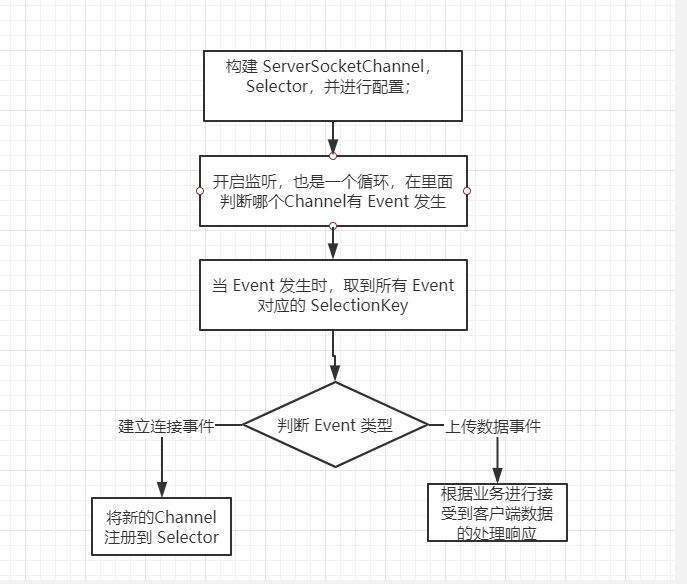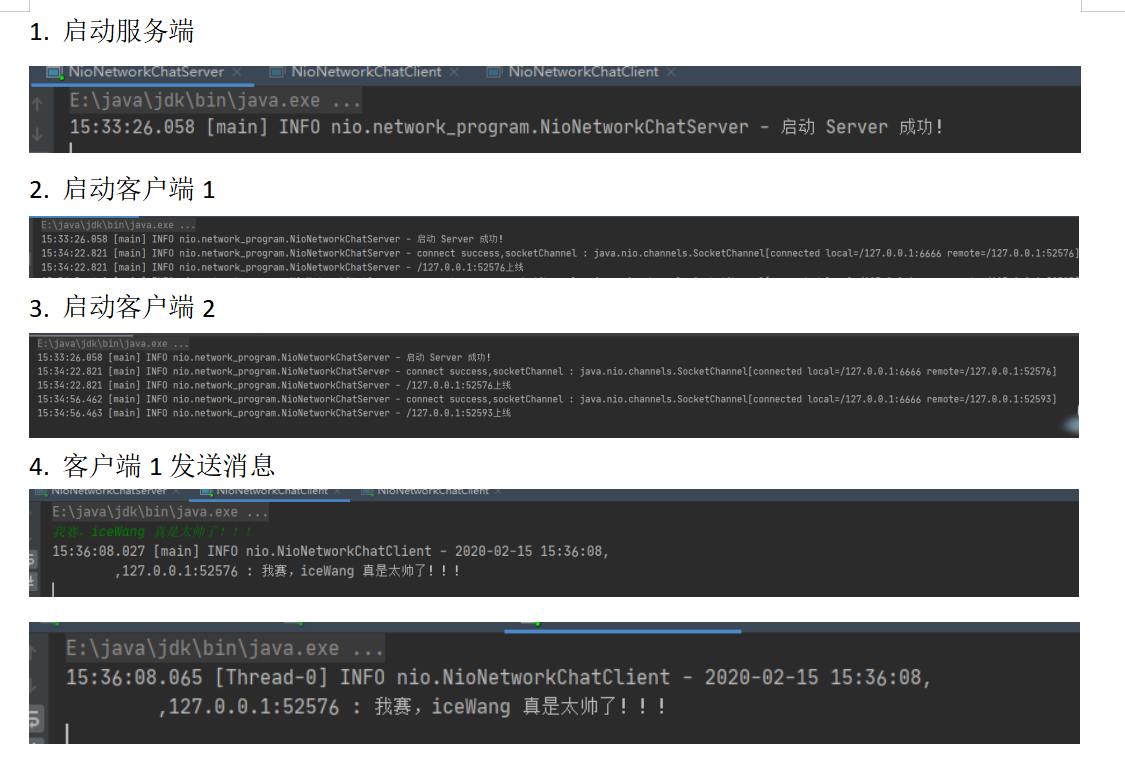Netty学习(4):NIO网络编程
2021-04-08 11:28
标签:can move class socket ide 根据 完成 lis cloud 在 Netty学习(3)中,我们已经学习了 Buffer 和 Channel 的概念, 接下来就让我们通过实现一个 NIO 的多人聊天服务器来深入理解 NIO 的第 3个组件:Selector。 在本文中,我们将通过实现一个网络聊天室程序,来掌握 Selector 的概念以及如何使用 NIO 来完成网络编程。 ? 设置一些属性,并在构造函数里设置这些属性的值 在这里,我们根据 selectionKey 来反向获取到 channel,通过 channel 将数据读入到 buffer 中,从而读进内存。 接着,将该消息转发给其他客户端。 最后,在 客户端的构建方法和 Server 基本一致,不同的是,Server 构建的是 ServerSocketChannel,Client 构建的是 SocketChannel,此外 Client 一开始注册的是 发送数据就很简单了,将数据简单封装一下,直接写入到 socketChannel 即可。 后面的结果就不在多演示了,跟这里的相似,这样,我们就完成了一个聊天室的程序,所有人可以在里面进行交流。 本文我们通过一个聊天室的程序,来演示了 Selector,Channel,Buffer 结合使用的效果,通过这 3者,我们实现了一个 NIO 的网络编程程序。 但在编写这个程序的时候,相信朋友们也发现了,其异常的繁琐,中间涉及到 Buffer 的构建,Selector 的 API 使用等等。因此,在日后的使用过程中,我们就要用到 Netty 来实现现在的工作,从而减少开发的工作量了。 ps:讲了那么多,终于要到 Netty 了,不过良好的基础是学习的关键,如果不懂 Java 的 IO 模型以及 NIO 的实现方式和局限性,也不会很好的理解学习 Netty。 本文中代码已上传到 GitHub 上,地址为 https://github.com/wb1069003157/nettyPre-research ,欢迎大家来一起讨论,一起进步。 文章在公众号「iceWang」第一手更新,有兴趣的朋友可以关注公众号,第一时间看到笔者分享的各项知识点,谢谢!笔芯! Netty学习(4):NIO网络编程 标签:can move class socket ide 根据 完成 lis cloud 原文地址:https://www.cnblogs.com/JRookie/p/12460541.html概述
目的
需求
实现逻辑图

代码实现
Server
设置通用属性
public class NioNetworkServer {
private Logger logger = LoggerFactory.getLogger(NioNetworkServer.class);
ServerSocketChannel serverSocketChannel;
Selector selector;
InetSocketAddress inetSocketAddress;
public NioNetworkServer() {
try {
// 生成一个 ServerSocketChannel 和 Selector,并将 ServerSocketChannel 绑定到指定端口
serverSocketChannel = ServerSocketChannel.open();
selector = Selector.open();
inetSocketAddress = new InetSocketAddress(6666);
serverSocketChannel.socket().bind(inetSocketAddress);
serverSocketChannel.configureBlocking(false);
// 将 serverSocketChannel(一开始的服务器Channel) 注册到指定selector上
// 后面给每一个连接生成的 SocketChannel,就是通过 ServerSocketChannel 来生成的
serverSocketChannel.register(selector, SelectionKey.OP_ACCEPT);
} catch (IOException e) {
logger.error("建立Server失败,失败原因:{0}", e);
}
}
}
监听方法
public void listen() {
try {
while (true) {
// 没有事件发生,就干其他事
if (selector.select(3000) == 0) {
continue;
}
// 得到有事件发生的事件集合,然后在后面可以通过其反向获取channel
Set连接请求
private void whenAccept() throws IOException {
// 因为此时已经有连接事件进入了,因此虽然 accept() 是阻塞的,但是在这里会直接返回
SocketChannel socketChannel = serverSocketChannel.accept();
logger.info("connect success,socketChannel : " + socketChannel.toString());
socketChannel.configureBlocking(false);
socketChannel.register(selector, SelectionKey.OP_READ, ByteBuffer.allocate(1024));
//将某人上线的消息进行显示
logger.info(socketChannel.getRemoteAddress() + "上线");
}读写数据
private void readData(SelectionKey selectionKey) throws IOException {
SocketChannel socketChannel = (SocketChannel) selectionKey.channel();
ByteBuffer byteBuffer = ByteBuffer.allocate(1024);
try {
socketChannel.read(byteBuffer);
String message = new String(byteBuffer.array());
logger.info("{}{}{}", LocalDateTime.now().format(DateTimeFormatter.ofPattern("yyyy-MM-dd HH:mm:ss")), "\n\t\t", message);
// 向其他的客户端转发消息
sendInfoToOtherClients(socketChannel, message);
} catch (Exception e) {
// 在捕获到异常后,就是有客户端发送了断开连接的请求
logger.info("{},离线了。。。", socketChannel.getRemoteAddress());
sendInfoToOtherClients(socketChannel, socketChannel.getRemoteAddress() + " 离线了。。。");
// 将关闭连接的 channel 关闭
socketChannel.close();
// 将该键移除出 set
selectionKey.cancel();
}
} private void sendInfoToOtherClients(SocketChannel socketChannel, String message) throws IOException {
for (SelectionKey key : selector.keys()) {
SelectableChannel sourceChannel = key.channel();
if (sourceChannel instanceof SocketChannel && sourceChannel != socketChannel) {
SocketChannel targetChannel = (SocketChannel) sourceChannel;
// 根据转发过来的字节长度,直接生成目标大小的 Buffer,然后将数据写入到客户端的 channel 中
ByteBuffer targetByteBuffer = ByteBuffer.wrap(message.getBytes());
targetChannel.write(targetByteBuffer);
}
}
}main 函数中启动即可。 public static void main(String[] args) {
NioNetworkServer nioNetworkServer = new NioNetworkServer();
nioNetworkServer.listen();
}Client
设置通用属性
public class NioNetworkChatClient {
private Logger logger = LoggerFactory.getLogger(NioNetworkChatClient.class);
private Selector selector;
private SocketChannel socketChannel;
private String username;
public NioNetworkChatClient() {
try {
selector = Selector.open();
InetSocketAddress inetSocketAddress = new InetSocketAddress("localhost", 6666);
socketChannel = SocketChannel.open(inetSocketAddress);
socketChannel.configureBlocking(false);
socketChannel.register(selector, SelectionKey.OP_READ);
username = socketChannel.getLocalAddress().toString().substring(1);
} catch (Exception e) {
logger.error("构建客户端错误,错误原因:{0}", e);
}
}
}
SelectionKey.OP_READ 事件。其他基本相似。读取数据
/**
* 1. 获取selector上发生的事件
* 2. 如果是读事件,则将数据通过 Channel 和 Buffer 进行操作
* 3. 处理完成后,将该key从待处理keys中删除
*/
public void readInfo() {
try {
int readChannel = selector.select();
if (readChannel > 0) {
Set发送数据
public void sendInfo(String info) {
info = username + " : " + info;
try {
logger.info("{},{},{}", LocalDateTime.now().format(DateTimeFormatter.ofPattern("yyyy-MM-dd HH:mm:ss")), "\n\t\t", info);
socketChannel.write(ByteBuffer.wrap(info.getBytes()));
} catch (IOException e) {
logger.error("发送数据错误,错误原因:{0}", e);
}
}启动
/**
* 1. 启动一个线程来定时读取 Server 可能发送的数据,如果没有,就休眠,等待下次读取
* 2. 启动一个获取控制台输出来进行数据的发送
*
* @param args
*/
public static void main(String[] args) {
NioNetworkChatClient nioNetworkChatClient = new NioNetworkChatClient();
// 线程资源必须通过线程池提供,不允许在应用中自行显式创建线程,但跟前面一样,这里因为不是重点,就先这样用着
new Thread() {
@Override
public void run() {
while (true) {
nioNetworkChatClient.readInfo();
try {
sleep(3000);
} catch (Exception e) {
e.printStackTrace();
}
}
}
}.start();
Scanner scanner = new Scanner(System.in);
while (scanner.hasNextLine()) {
String message = scanner.nextLine();
nioNetworkChatClient.sendInfo(message);
}
}演示结果

总结

上一篇:PHP的for循环
下一篇:爬虫01-urllib常用函数
文章标题:Netty学习(4):NIO网络编程
文章链接:http://soscw.com/index.php/essay/72851.html